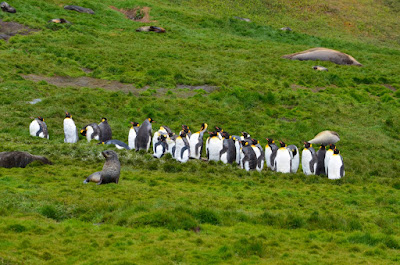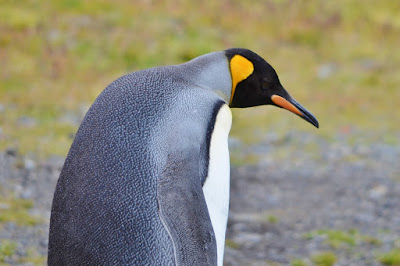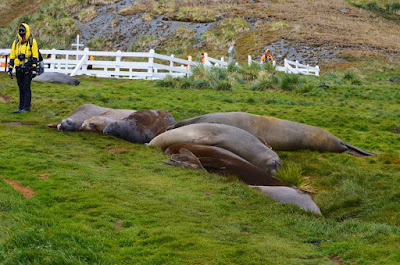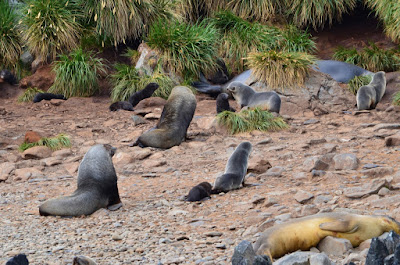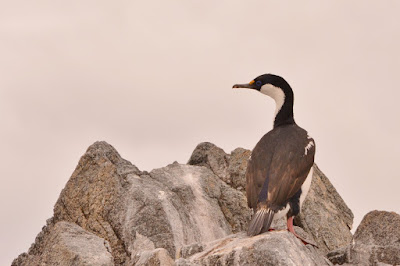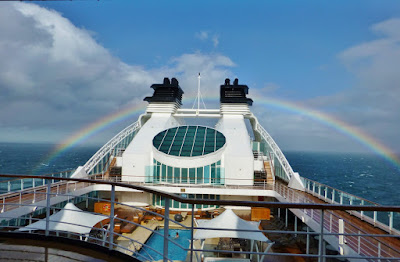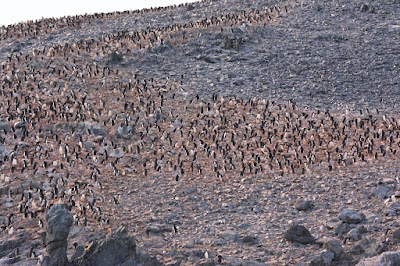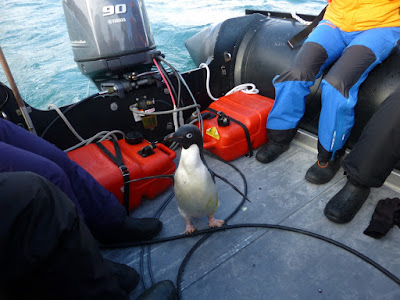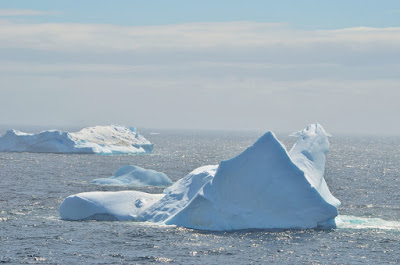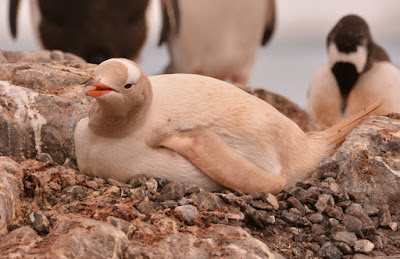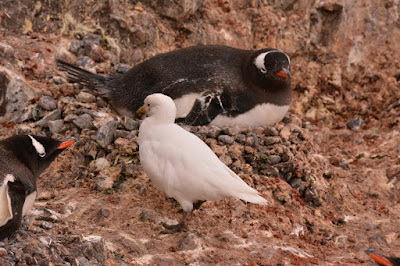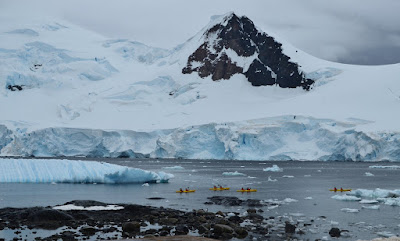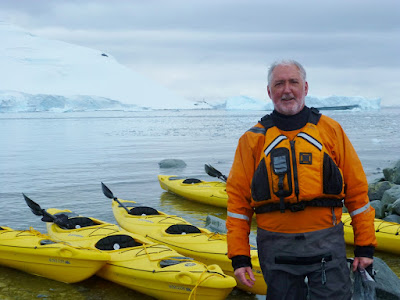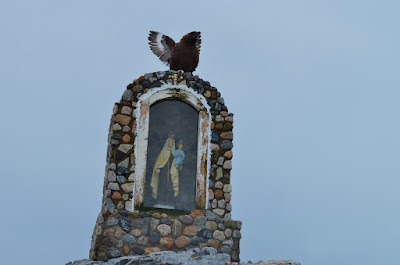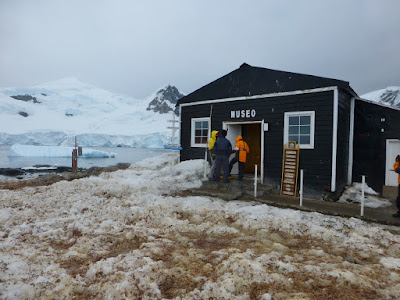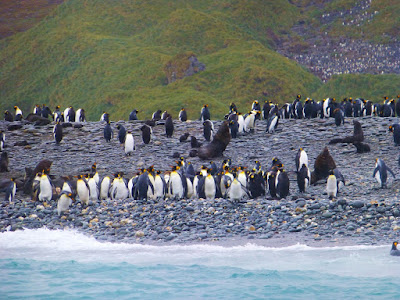January 8 – Salisbury Plain and Albatross Island
At dawn we reached our destination, which was barely visible in the mist, rain and fog. The swell was significant, and the wind was gusting to 40 knots. The Captain looked for a lee, and for a while it did not look good. Then the wind lessened and the Seabourn Quest moved closer to the Salisbury Plain and the immense King Penguin rookery, with 750,000 breeding pairs spread out over the hillsides and level ground between two glaciers. The penguins shared the beach with southern fur seals, elephant seals and opportunistic Great Petrels, Skua’s, Kelp Gulls and even some Terns. Even from the ship we could hear the cries of the King Penguins, sounding like wind moaning in the rigging of a ship. The surf was too high for a safe landing, so we cruised along the shore just outside the surf line. The rain and wind made the experience cold, but visually exciting, even though photos were difficult and poor quality in the flat light and rain
 |
| Patrick headed out on the final zodiac tour |
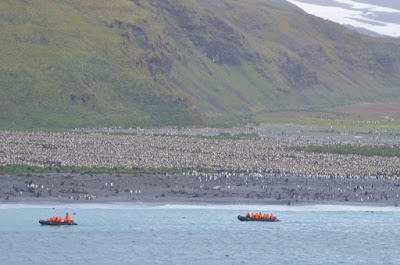 |
| Cruising along the beach in front of the rookery |
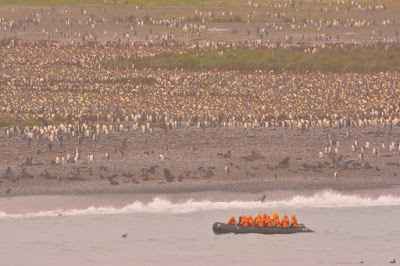 |
| The rookery stretches for more than 1 mile |
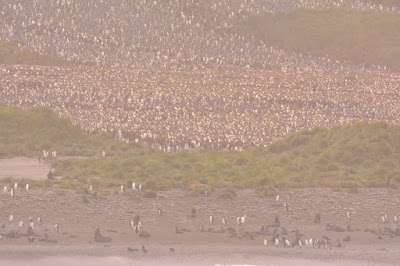 |
| And to the top of the hills |
The abundance of life also meant that we saw death and feeding as the birds and seals did what they needed to do to survive. By 1130 all groups had had a chance to do a zodiac tour and the Seabourn Quest headed for Montevideo. The weather for at least the first 24 hours is for 4 meter seas on the beam with winds to 30 knots.
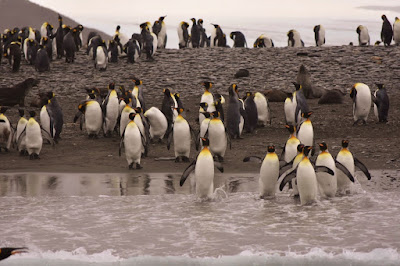 |
| Marching into the sea |
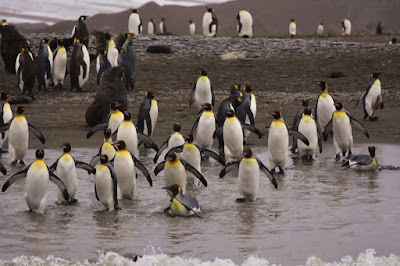 |
| Seeming to like doing it as a group |
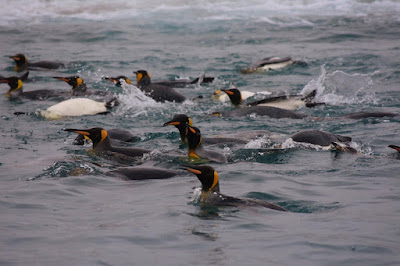 |
| King Penguins swimming |
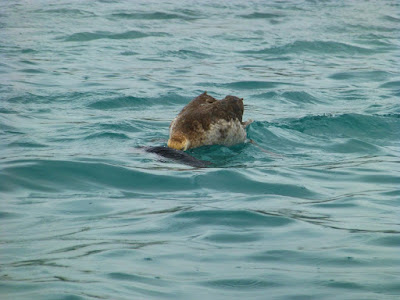 |
| Petrel feasting on a fur seal pup |
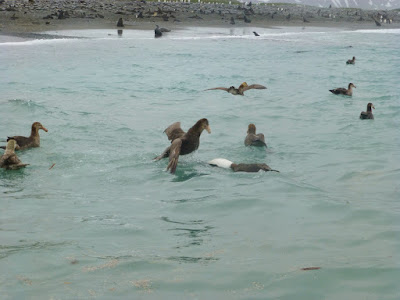 |
| And arguing over a King Penguin |
As we departed in the rain and wind, Miriam and I stopped for lunch at the Patio Grill, all wrapped up in blankets and the 34 degree wind whipped around the diehards like us who like the menu, the staff and the ambiance of sitting outside watching the swells pass by the ship and the water sloshing out of the pool. The Thomas Keller burgers were good, as usual, along with a hot Gluvein wine and a warm rice pudding.
Returning to our stateroom, we both laid down for a nap and woke up barely in time to attend the final recap briefing from the expedition team before going to the Colonnade for a Tuscan buffet, joining Eva and Dave Schoonmaker. While there we saw what will probably be our last tabular iceberg of the trip, in the distance, but nearly 5 miles long.
The Seabourn Quest continues to rock and roll as we head into a weather system with winds predicted to increase for at least 24 hours as low pressure systems sweep eastward from the Pacific Ocean through the Drake Passage and into the Atlantic. The sun is setting and we can see squall lines on the horizon as the seas continue to build from the west, rolling towards us relentlessly. At least we no longer have blackout conditions and can leave the stateroom drapes open.
We have finished Antarctica, and it will take some time to digest what we saw. The Chilean fjords seem like a dream from the past, and we will never look at SE Alaska in quite the same way.
January 9 – At Sea
During the night we continued on a direct course for Montevideo. The wind and seas continued unabated from the west, putting them nearly on the beam. Even a ship the size of ours, even stabilized, rocked, rolled and slammed through the the night. Morning brought partly cloudy skies and swells greater than 5 meters right on the beam.
January 10 – At Sea
Another day of heavy seas, winds and general discomfort as we slogged NW towards Montevideo. Today was the crew epicurean event on the Patio, with foods and drinks from a number of nations. We ended up eating dinner at the Patio Grill rather than changing into “elegant casual” attire. Patrick attended some of the final lectures of the cruise.
January 11 – At Sea
The weather is finally improving, with calm seas and lower winds. Packing for the trip home started. Lunch at the patio grill, a session in the bow whirlpool and the crew farewell with the last formal dinner capped off the evening. We also got a bridge tour.
January 12 – Montevideo
As the sun rose, the Seabourn Quest pulled into the breakwater protecting the harbor. Outside the breakwater was a mass of abandoned and sinking fishing vessels. The ship docked at the commercial port, just a few slips from the Zaandam, which we had last seen cruising in Antarctica several weeks ago.
Our shore excursion started with a bus tour of the city, with several photo stops. We then went slightly out of the city to the Bouza Winery for a tour, tasting and lunch, which turned into a fiasco, with slow service, not enough food and general lack of ability to handle the number of guests. Returning to the ship we gathered for final drinks and chats with our cruising friends of the last 24 days before returning to the suite to finalize packing and leave the bags outside the door.
January 13 – Buenos Aires
Due to a small cruise terminal and several ships, we left the Seabourn Quest at 0745. We were greeted by the Captain and staff as we left, very moving.
After some minor confusion outside the terminal getting into our private van to the hotel, we entered the lobby of the Park Hyatt about 0830 and then had to wait until 1000 for a room, as there were an equal number of guests checking out to get on the ship for the next voyage. Relaxing on the terrace over coffee we phoned Carlos Ormachea and arranged to meet for dinner. The rest of the day was spent walking in the Recoleta area of the city, visiting the impressive cemetery, churches and then lunch at a German themed restaurant.
Meeting Carlos at 2000, we headed to an Argentine beef restaurant just a few blocks from the hotel and gorged on three different kinds of beef while catching up on 29 years. Returning to the hotel, we sat on the terrace and sipped single malt whiskey and coffee before calling it a night at 1230 am.
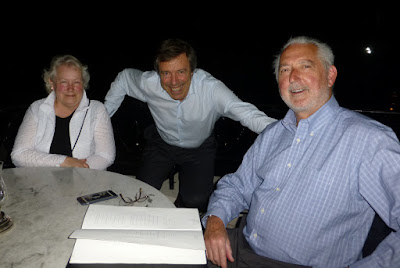 |
| Sloan Fellow Classmate Carlos Ormachea with Miriam & Patrick |
January 14, Buenos Aires
After a leisurely breakfast on the terrace of the Duhua Palace (Park Hyatt), we headed to the Estancia Santa Susanna for a day with the Gauchos and another beef extravaganza. Returning to the hotel we found the “Sorrento” Mediterranean Bistro for a light seafood dinner before a nightcap on the terrace of the hotel.
January 15 – Buenos Aires to Dallas
After another lazy morning, a brief tour of the area, we had lunch at a local sandwich shop and then to the airport. The check-in process was slow, but we got to the lounge, found a power outlet that worked and then boarded our American Airlines flight to Dallas. The 777, while old, was adequate and the crew provided a loaner charger for our iPads. The service was great!
January 16 – Dallas to Vancouver
Our flight landed just as US Customs was opening at 0500. We did not have to claim our bags; they were transferred directly to the Vancouver flight. Finding a lounge close to our gate, we were able to use the showers and relax until our flight was called at 0900. The flight was on-time and uneventful, as was the customs and immigration procedures in Vancouver.














